To elevate your drone video skills, master pro flight techniques that transform amateur footage into cinematic masterpieces. Start by understanding your drone's capabilities and perfecting basic controls. Focus on smooth take-offs, landings, and hovering before tackling advanced maneuvers. Apply composition rules like the rule of thirds and leading lines to create visually appealing shots. Utilize automated flight modes for complex sequences, but practice manual control for precision. Post-processing is essential; color grade and stabilize your footage for a polished look. Overcome common challenges by planning ahead and prioritizing safety. By honing these techniques, you'll reveal new creative possibilities in aerial videography.
Key Takeaways
- Master smooth camera movements through gentle stick inputs and practice of basic maneuvers before complex shots.
- Utilize dynamic flight patterns like orbits, reveals, and vertical sweeps to create engaging and cinematic footage.
- Apply composition rules such as the rule of thirds, leading lines, and foreground elements for visually appealing shots.
- Prioritize safety by scouting locations, maintaining awareness, and practicing obstacle avoidance techniques.
- Perfect hovering, panning, and tilting techniques to achieve stable and professional-looking aerial videography.
Understanding Your Drone's Capabilities
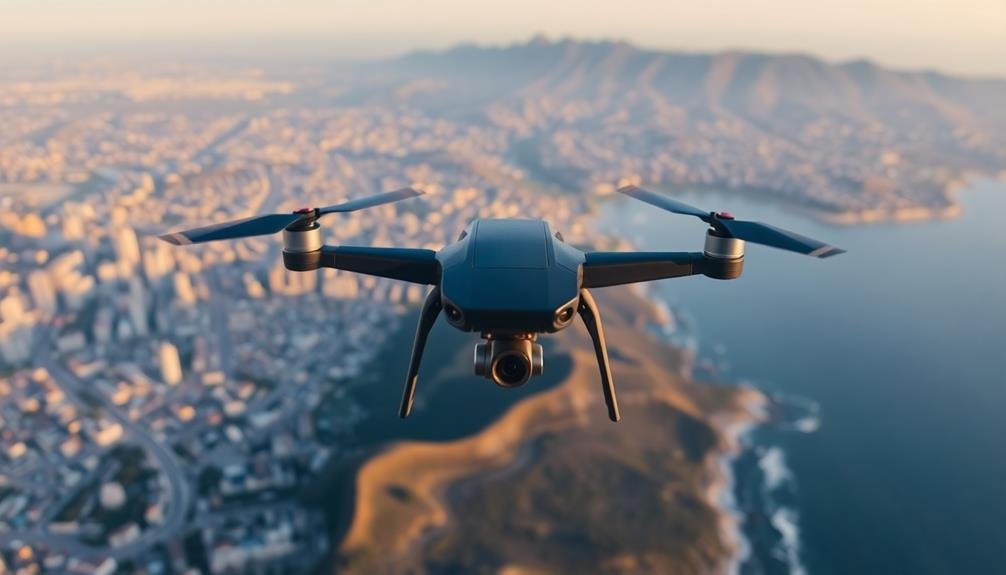
How well do you know your drone? Understanding its capabilities is essential for mastering pro flight techniques.
First, familiarize yourself with your drone's flight modes. Most models offer standard modes like GPS, ATTI, and Sport, each with unique characteristics. GPS mode provides stability and position holding, while ATTI allows for more manual control. Sport mode reveals higher speeds but sacrifices some stability.
Next, learn your drone's maximum flight time and range. These factors influence your shooting plans and guarantee you don't lose your aircraft mid-flight. Pay attention to wind resistance ratings, as they'll dictate when it's safe to fly in various conditions.
Study your camera's specs, including sensor size, resolution, and frame rates. This knowledge helps you choose the best settings for different shots.
Don't forget about gimbal limitations – knowing its tilt and pan ranges will inform your composition choices.
Lastly, understand your drone's obstacle avoidance capabilities. Some models have 360-degree protection, while others may have blind spots. This awareness is fundamental for traversing tight spaces and guaranteeing your drone's safety during complex maneuvers.
Pre-Flight Checklist and Setup
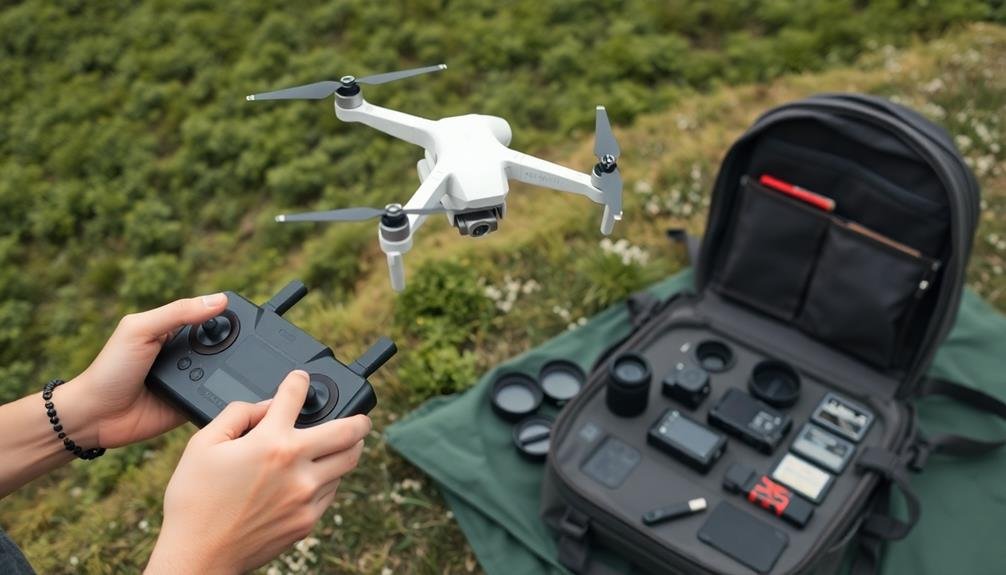
Before you take off, conduct a thorough equipment inspection and prepare your drone for flight.
Scout your location carefully, considering potential obstacles, weather conditions, and legal restrictions.
Optimize your camera settings based on lighting conditions and your shooting objectives to capture the best possible footage.
Equipment Inspection and Preparation
Three critical steps form the foundation of a safe and successful flight: equipment inspection, preparation, and following a pre-flight checklist.
Begin by thoroughly examining your drone for any visible damage or loose components. Check propellers for cracks or chips, and guarantee they're securely attached. Inspect the battery for swelling or damage, and verify it's fully charged.
Next, prepare your equipment. Clean your camera lens and gimbal, and format your memory card. Install any necessary filters and guarantee your remote controller is charged.
Don't forget to update your drone's firmware and calibrate its compass if needed.
Finally, run through your pre-flight checklist. Confirm GPS signal strength and set your home point. Check local regulations and airspace restrictions.
Assess weather conditions, including wind speed and direction. Set your camera settings according to your shooting goals.
Location Scouting Considerations
When it comes to location scouting, thorough preparation is key to a successful drone flight. Before you take off, carefully assess your surroundings and potential hazards. Check local regulations and obtain necessary permits for your chosen location. Familiarize yourself with the area's terrain, obstacles, and weather patterns to guarantee a safe and productive flight.
Consider these essential factors during your location scouting:
- Airspace restrictions and no-fly zones
- Potential electromagnetic interference sources
- Sun position and lighting conditions
- Wind patterns and forecasted weather
- Available landing areas and emergency spots
Once you've identified a suitable location, create a flight plan that outlines your intended path and shot list. Mark key points of interest and potential risks on a map.
Don't forget to scout for a comfortable and safe area to set up your ground control station. This spot should offer a clear line of sight to your drone and protection from the elements.
Camera Settings Optimization
How can you guarantee your drone's camera is ready to capture breathtaking aerial footage? Start by optimizing your camera settings before takeoff. Adjust your resolution and frame rate based on your project's requirements. For cinematic footage, use 4K at 24fps, while action shots benefit from 1080p at 60fps or higher.
Set your ISO as low as possible to minimize noise, typically between 100-400. Choose the appropriate white balance for your lighting conditions, or use auto if you're unsure. Enable your drone's histogram to monitor exposure and avoid clipping highlights or shadows.
| Setting | Recommendation |
|---|---|
| Resolution | 4K for cinematic, 1080p for action |
| Frame Rate | 24fps for film, 60fps+ for action |
| ISO | 100-400 for minimal noise |
| White Balance | Match lighting or use auto |
Don't forget to format your memory card and verify it has enough space for your planned flight time. Set your camera to shoot in RAW format for maximum post-processing flexibility. Finally, double-check your gimbal calibration and ND filter selection based on lighting conditions. By carefully optimizing these settings, you'll be ready to capture stunning aerial footage as soon as your drone takes flight.
Basic Flight Controls Mastery
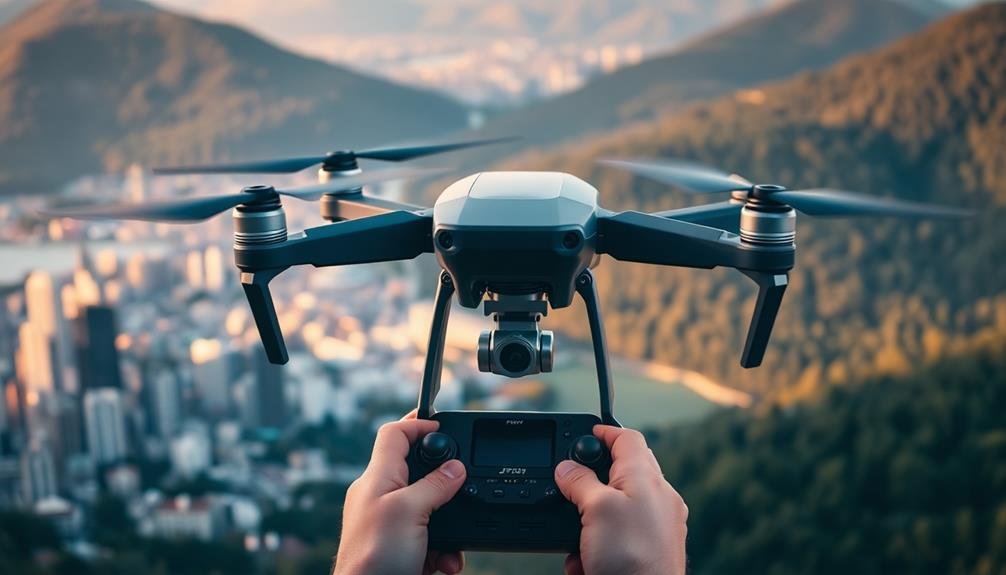
To become a proficient pilot, mastering basic flight controls is essential. You'll need to familiarize yourself with the drone's remote controller and understand how each stick and button affects your aircraft's movement.
Focus on smooth, controlled inputs to achieve fluid motion in your footage.
Practice these fundamental maneuvers:
- Hovering steadily in one position
- Ascending and descending vertically
- Flying forward and backward in a straight line
- Performing controlled yaw rotations
- Executing gentle turns and curves
As you gain confidence, combine these basic movements to create more complex flight patterns. Remember to maintain a consistent altitude and speed during your maneuvers. This will result in smoother, more professional-looking footage.
Don't rush the learning process. Spend ample time mastering each control individually before attempting to use them simultaneously.
Start in an open area with minimal obstacles to reduce the risk of collisions. As your skills improve, gradually introduce more challenging environments and flight scenarios.
Smooth Take-Offs and Landings
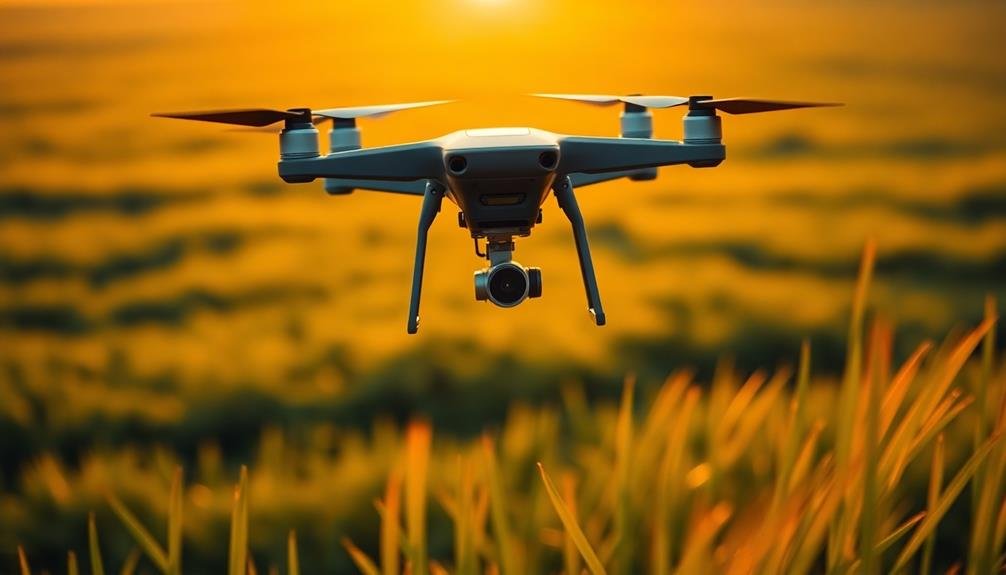
Once you've mastered basic flight controls, it's time to perfect your take-offs and landings. These vital moments can make or break your footage, so focus on smooth, controlled movements.
For take-offs, start with your drone on a flat surface. Gradually increase throttle until the drone lifts off, then maintain a steady ascent. Keep the drone level and avoid sudden movements that could destabilize it.
When landing, approach slowly and steadily. Use visual cues to gauge your altitude and position. As you near the ground, reduce throttle gradually to maintain control. Aim for a gentle touchdown, avoiding abrupt movements that could cause the drone to tip or bounce.
Practice in open areas with minimal obstacles until you're comfortable. Pay attention to wind conditions, as they can affect your drone's stability during take-off and landing. Always verify your landing zone is clear and suitable.
For advanced techniques, try precision landings on specific targets or practice one-handed take-offs and landings. Remember, smooth operations not only produce better footage but also reduce wear and tear on your equipment.
Perfecting Hovering Techniques
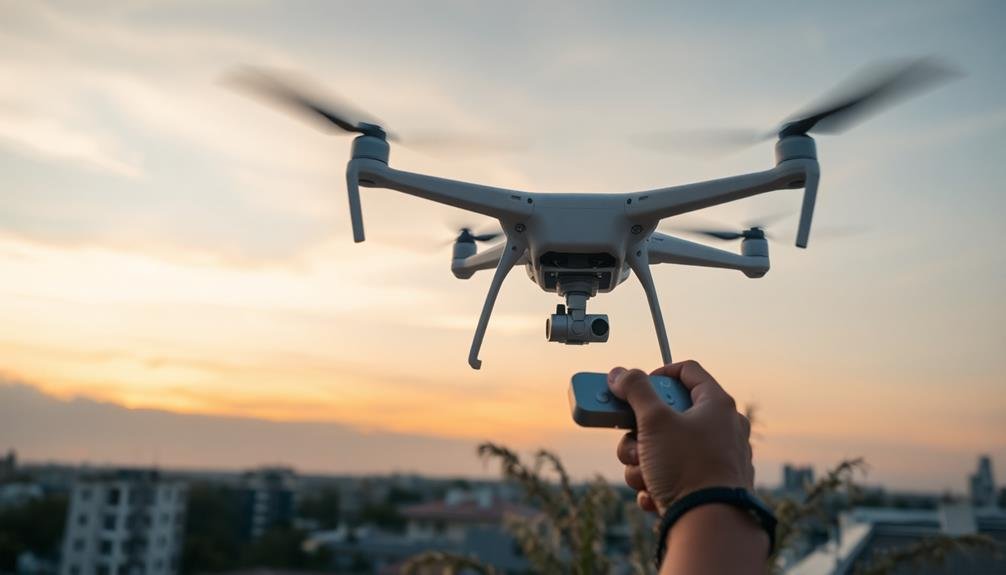
Building on your take-off and landing skills, mastering hovering techniques is essential for capturing steady footage and maintaining control in tight spaces. To perfect your hovering, focus on subtle joystick movements and constant adjustments. Keep your drone at a consistent altitude by using the throttle carefully, and maintain its position by gently nudging the right stick.
Practice hovering in various conditions to improve your skills:
- Indoors, where there's no wind
- Outdoors on a calm day
- In light winds to challenge yourself
- At different altitudes
- Near obstacles for added complexity
As you practice, pay attention to your drone's behavior and learn to anticipate its movements. Use visual references to help maintain position, such as aligning with nearby objects or ground markings.
Don't forget to utilize your drone's intelligent flight modes, like GPS hold or altitude hold, to assist with stability. Remember, mastering hovering takes time and patience. Start with short durations and gradually increase as you become more comfortable.
With consistent practice, you'll soon be able to capture smooth, professional-looking footage in even the most challenging environments.
Mastering Panning and Tilting
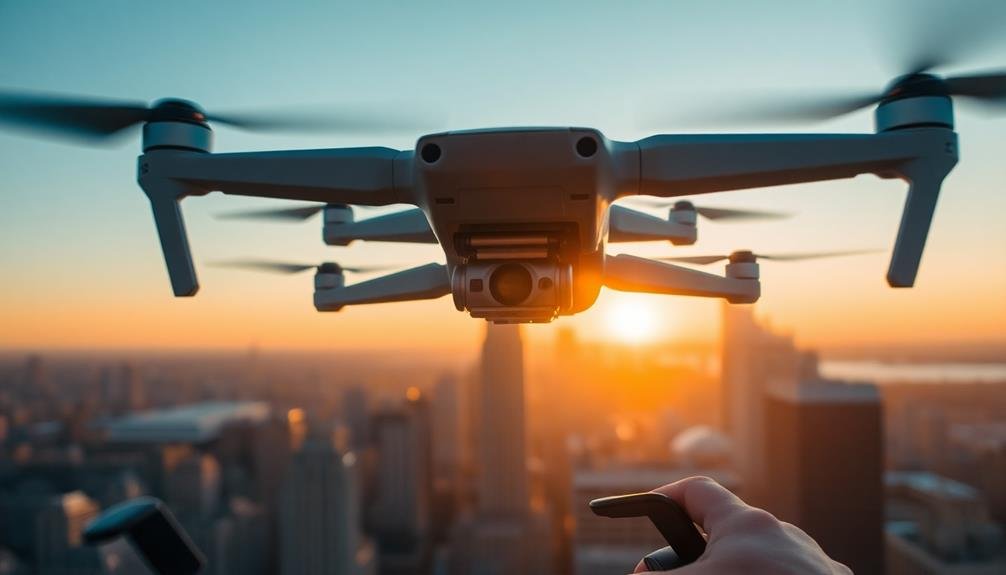
Mastering panning and tilting techniques elevates your drone footage from amateur to professional. These movements allow you to capture dynamic, cinematic shots that engage your audience and tell a compelling visual story.
To execute smooth pans, start with your drone stationary, then slowly move it horizontally. For tilts, adjust the camera angle vertically while keeping the drone in place. Practice these movements separately before combining them for more complex shots.
Here's a quick reference guide for panning and tilting:
| Movement | Speed | Direction | Best Used For |
|---|---|---|---|
| Pan | Slow | Left/Right | Landscapes |
| Pan | Fast | Left/Right | Action Scenes |
| Tilt | Slow | Up/Down | Reveal Shots |
| Tilt | Fast | Up/Down | Dramatic Effect |
Remember to maintain a consistent speed throughout your movements. Use the drone's intelligent flight modes, such as Point of Interest or Waypoints, to achieve perfectly smooth pans and tilts. Experiment with different speeds and angles to find what works best for your specific shot. With practice, you'll develop a feel for when to use these techniques to create visually stunning footage.
Creating Cinematic Aerial Shots
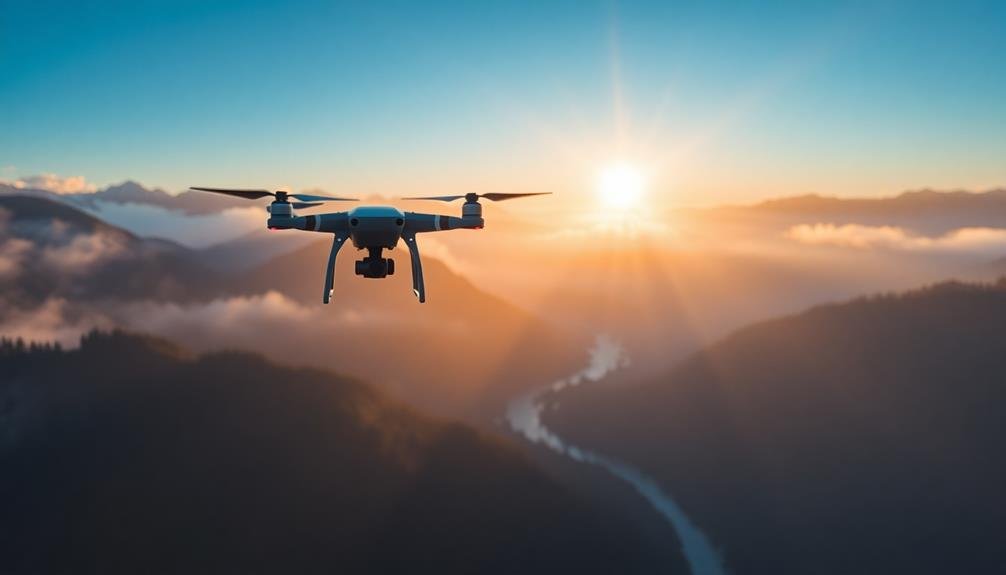
To create cinematic aerial shots, you'll need to master three key elements.
First, focus on achieving smooth camera movements that mimic Hollywood-style cinematography.
Next, pay close attention to your composition and framing, ensuring each shot tells a compelling visual story.
Smooth Camera Movements
Elegance in aerial cinematography hinges on smooth camera movements. To achieve fluid shots, you'll need to master both flight control and camera operation simultaneously. Start by practicing basic maneuvers like pans, tilts, and tracking shots. As you gain confidence, experiment with more complex movements, combining multiple techniques for dynamic sequences.
When executing camera movements, remember these key points:
- Use gentle stick inputs to avoid jerky motions
- Maintain a consistent speed throughout the shot
- Anticipate your endpoint and begin slowing down early
- Utilize your drone's intelligent flight modes for precise movements
- Practice shifts between different shot types
Mastering smooth movements requires patience and practice. Begin with simple, slow movements and gradually increase complexity and speed.
Pay attention to your surroundings and plan your shots in advance to guarantee safety and ideal framing.
To further refine your technique, review your footage critically. Analyze what works well and identify areas for improvement. Don't be afraid to reshoot scenes until you achieve the desired smoothness.
With time and dedication, you'll develop an intuitive feel for fluid aerial cinematography, elevating your productions to professional levels.
Composition and Framing
Composition and framing form the backbone of cinematic aerial shots. To create visually striking footage, you'll need to master these elements. Start by applying the rule of thirds, dividing your frame into a 3×3 grid and placing key subjects along these lines or at their intersections. This creates a balanced and engaging composition.
Consider the leading lines in your shots, using natural or man-made features to guide the viewer's eye through the frame. Incorporate foreground elements to add depth and context to your aerial footage. When filming landscapes, try to include a point of interest, such as a lone tree or building, to give scale and focus to the shot.
Experiment with different angles and perspectives. Low altitude flights can create dramatic, sweeping shots, while higher altitudes offer a broader view of the landscape. Use negative space effectively to emphasize your subject and create a sense of isolation or vastness.
Pay attention to symmetry and patterns in natural and urban environments, as these can produce visually striking compositions. Finally, don't forget to leave room for movement within the frame, especially when following a subject or revealing a landscape.
Dynamic Flight Patterns
Dynamic flight patterns are vital for creating intriguing aerial shots that keep viewers engaged. By mastering various flight techniques, you'll elevate your drone footage from ordinary to extraordinary. Start by practicing smooth, controlled movements that showcase the landscape or subject from different angles.
Combine these movements with changes in altitude and speed to add depth and interest to your shots.
Experiment with these dynamic flight patterns:
- Orbit: Circle your subject while keeping it centered in the frame
- Reveal: Start with an obstructed view, then slowly move to reveal the full scene
- Dolly zoom: Fly towards your subject while zooming out (or vice versa)
- Vertical sweep: Ascend or descend smoothly to show scale and perspective
- Follow: Track a moving subject from behind or alongside
As you practice these patterns, focus on maintaining steady movements and smooth shifts between shots. Pay attention to your surroundings and make sure you're flying safely and legally.
Remember that timing is significant; plan your shots to coincide with interesting lighting conditions or events. By incorporating these dynamic flight patterns into your aerial videography, you'll create engaging footage that stands out from the crowd.
Advanced Maneuvers for Dynamic Footage

Mastering advanced maneuvers will elevate your drone footage from ordinary to extraordinary. These techniques require practice and precision but can yield stunning results.
Start with the orbit maneuver, where you circle a subject while keeping it centered in the frame. Gradually increase altitude during the orbit for a dynamic disclosure effect.
Next, try the dolly zoom, also known as the vertigo effect. Fly backwards while zooming in, or forwards while zooming out, to create a disorienting visual impact.
For smooth reveals, master the fly-through technique. Navigate your drone through tight spaces or natural formations to dramatically disclose landscapes or subjects.
The helix maneuver combines vertical movement with a circular path, creating a corkscrew effect around your subject.
To capture expansive scenes, perfect the dronie—start close to your subject and fly backwards and upwards simultaneously.
For action sequences, attempt the flyby. Swoop past your subject at high speed, maintaining focus throughout.
Finally, master the top-down reveal by starting directly above your subject and slowly descending while tilting the camera.
These advanced maneuvers will add cinematic flair to your drone footage.
Obstacle Avoidance and Safety
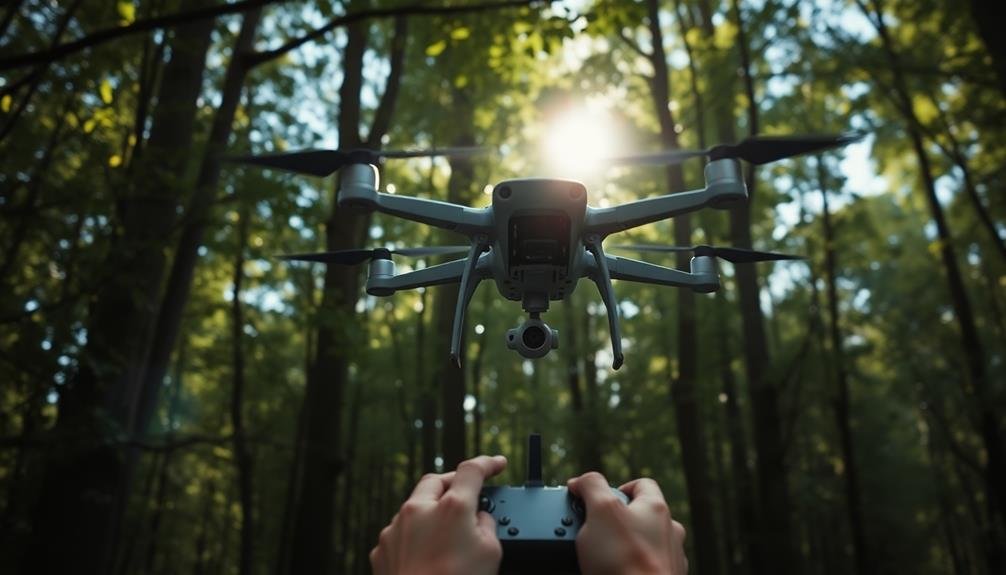
With safety as your top priority, obstacle avoidance becomes an essential skill for any drone pilot. You'll need to master this technique to protect your equipment, comply with regulations, and guarantee the safety of people and property around you.
Start by thoroughly scouting your flight area before takeoff, identifying potential hazards like trees, power lines, and buildings.
Develop a keen awareness of your drone's position in 3D space at all times. Use your controller's obstacle avoidance sensors, if available, but don't rely on them entirely. Practice maintaining a safe distance from obstacles, typically at least 10 feet.
When flying in tight spaces, reduce your speed and increase your focus.
To enhance your obstacle avoidance skills:
- Familiarize yourself with your drone's turning radius
- Practice flying figure-eight patterns around objects
- Experiment with different camera angles to improve spatial awareness
- Use visual markers or props for precision flight training
- Gradually increase difficulty by flying in more complex environments
Composition Rules for Aerial Videography
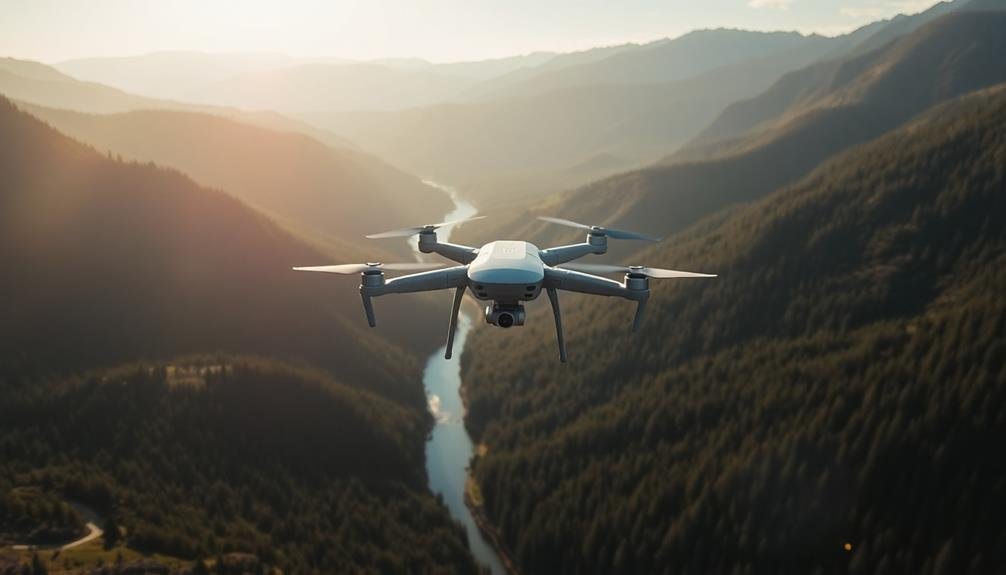
Creating stunning aerial footage goes beyond simply pointing your drone's camera at a subject. To elevate your aerial videography, you'll need to master key composition rules. Start by applying the rule of thirds, dividing your frame into a 3×3 grid and placing points of interest along the intersecting lines. This creates a more balanced and visually appealing shot.
Incorporate leading lines to guide the viewer's eye through the frame. Natural features like roads, rivers, or coastlines work well for this.
Don't forget about symmetry and patterns, which can create mesmerizing aerial shots. When capturing landscapes, use the horizon line to your advantage by placing it in the upper or lower third of the frame, depending on whether you want to emphasize the sky or ground.
Consider the direction and speed of your drone's movement. Smooth, steady movements often produce the most professional-looking results. Experiment with different angles and altitudes to find unique perspectives.
Remember to maintain a safe distance from your subject and respect local regulations. By mastering these composition techniques, you'll transform your aerial footage from ordinary to extraordinary, creating visually stunning and engaging videos that captivate your audience.
Utilizing Automated Flight Modes
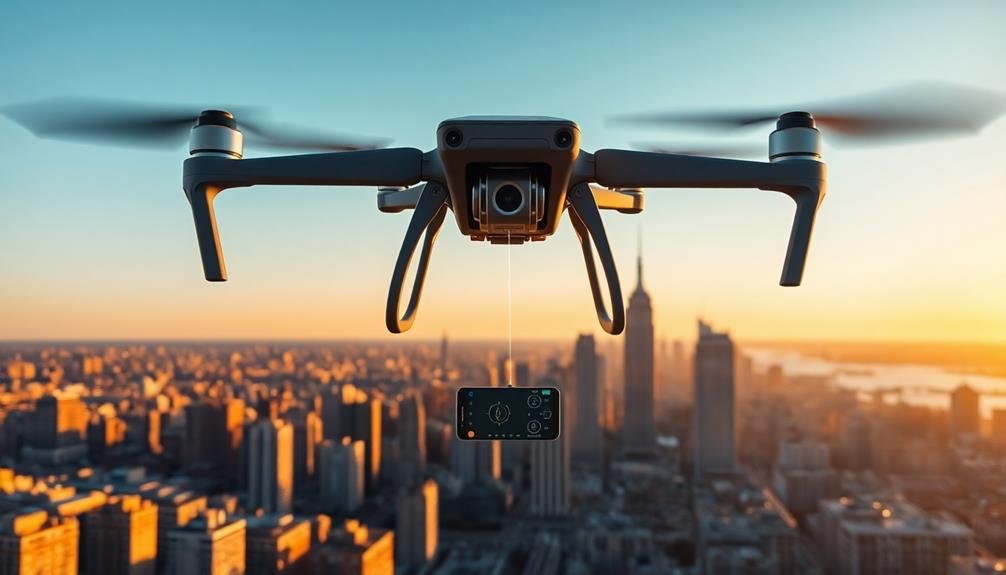
While composition skills are essential for aerial videography, modern drones offer powerful automated flight modes that can take your footage to new heights. These modes allow you to focus on capturing stunning visuals while the drone handles complex flight patterns. You'll find options like orbit, waypoint, and tracking modes on most advanced drones.
To make the most of automated flight modes:
- Familiarize yourself with each mode's capabilities and limitations
- Practice in open areas before attempting complex shots
- Plan your shots in advance, considering lighting and obstacles
- Use smooth, gradual movements for more cinematic results
- Combine different modes to create unique sequences
When using orbit mode, set your point of interest carefully and adjust altitude for varied perspectives.
Waypoint mode lets you pre-program complex flight paths, ideal for revealing landscapes or architectural features.
Tracking modes are perfect for action shots, following subjects automatically while maintaining smooth camera movements.
Don't forget to monitor your drone's battery life and maintain visual line of sight during automated flights.
Post-Processing Drone Footage

After capturing stunning aerial footage, you'll need to elevate it through post-processing techniques.
Start by applying color grading and correction to enhance the visual appeal.
Then focus on stabilization and smoothing to eliminate any unwanted camera shake.
Color Grading and Correction
Once you've captured stunning aerial footage with your drone, color grading and correction become essential steps in post-processing to elevate your visuals.
These techniques allow you to enhance the mood, create a consistent look, and correct any color issues in your footage.
Start by adjusting the basic parameters like exposure, contrast, and white balance.
Then, move on to more advanced color grading techniques, such as manipulating the highlights, midtones, and shadows separately.
Use tools like color wheels, curves, and LUTs (Look-Up Tables) to achieve your desired aesthetic.
When color grading drone footage, keep these tips in mind:
- Maintain natural-looking skies and landscapes
- Enhance golden hour footage for a warm, cinematic look
- Use subtle adjustments to avoid an over-processed appearance
- Create a consistent color palette across your entire video
- Consider the mood and story you want to convey
Remember to frequently compare your graded footage with the original to verify you're not overdoing the effects.
With practice, you'll develop your own unique style and create visually striking drone videos that captivate your audience.
Stabilization and Smoothing
Despite modern drones' built-in stabilization features, you'll often need to apply additional smoothing in post-processing to achieve perfectly stable footage. Most video editing software offers built-in stabilization tools that analyze your footage and compensate for unwanted movement.
Start by applying these automatic stabilization effects, adjusting the strength to find the right balance between smoothness and maintaining natural motion.
For more precise control, consider using dedicated stabilization software like ReelSteady GO or Mercalli. These tools offer advanced algorithms and customizable settings to tackle even the most challenging shots.
When stabilizing, pay attention to any warping or distortion, especially around the edges of the frame. You may need to crop your footage slightly to eliminate these artifacts.
If you're dealing with particularly shaky footage, try using a combination of stabilization techniques. Start with warp stabilizer, then apply a subtle rolling shutter reduction, and finally, add a touch of motion blur to smooth out any remaining jitters.
Adding Cinematic Effects
The art of adding cinematic effects to your drone footage can elevate your videos from amateur to professional-looking in post-processing.
Start by adjusting color grading to create a cohesive look throughout your footage. Experiment with LUTs (Look-Up Tables) to quickly apply cinematic color profiles.
Next, add subtle lens flares or light leaks to enhance the atmosphere and create a more immersive experience.
Don't overlook the power of sound design. Incorporate ambient noise, music, and sound effects to complement your visuals and evoke emotions.
Consider adding slow-motion effects to highlight key moments and create a more dramatic feel. Finally, experiment with transitions to seamlessly blend your shots together.
Here are some popular cinematic effects you can try:
- Letterboxing for a widescreen cinema look
- Vignettes to draw focus to the center of the frame
- Film grain for a vintage aesthetic
- Motion blur to enhance the sense of movement
- Parallax effect to add depth to still images
Overcoming Common Filming Challenges
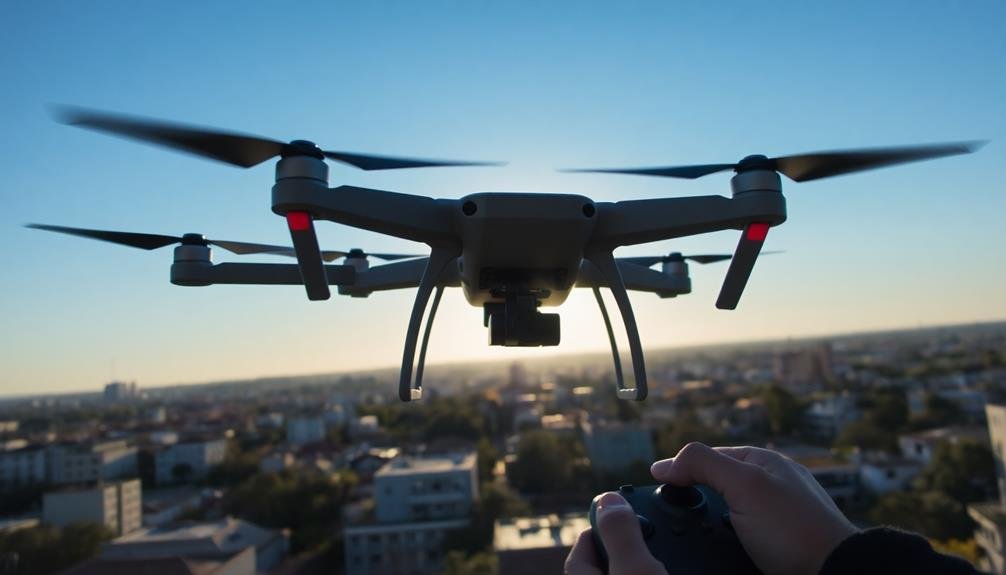
Mastering aerial cinematography comes with its fair share of obstacles. You'll often encounter challenges like wind interference, battery limitations, and restricted flight zones.
To combat wind, plan your shots during calmer periods of the day and use a drone with strong wind resistance. Always carry spare batteries and plan your flight path to maximize shooting time. Research local regulations and use apps to identify no-fly zones before taking off.
Lighting conditions can make or break your footage. Shoot during the golden hour for ideal natural light, or use neutral density filters to control exposure in bright conditions.
When filming moving subjects, practice your tracking skills and use intelligent flight modes to maintain smooth camera movements.
Stability is essential for professional-looking footage. Master your drone's controls and utilize features like tripod mode for steady shots. In post-production, use stabilization software to further refine your footage.
Finally, always prioritize safety. Maintain visual line of sight with your drone, avoid flying over people, and be prepared for emergency landings.
Frequently Asked Questions
How Do Weather Conditions Affect Drone Battery Life During Flights?
Weather greatly impacts your drone's battery life. Cold temperatures reduce efficiency, while wind makes your drone work harder. Heat can cause overheating. Rain and humidity pose risks. Always check conditions and plan flights accordingly to maximize battery duration.
What Are the Best Practices for Storing and Transporting Drone Batteries?
Store your drone batteries in a cool, dry place. Don't leave them fully charged for long periods. Use a fireproof case for transport. Keep them at room temperature and avoid extreme conditions. Always follow manufacturer guidelines.
How Can I Legally Fly My Drone for Commercial Purposes?
To legally fly your drone commercially, you'll need to obtain a Part 107 license from the FAA. You must pass a written exam, register your drone, and follow all FAA regulations for commercial drone operations.
What Insurance Options Are Available for Drone Operators?
You've got several insurance options as a drone operator. You'll want to take into account liability coverage, hull insurance for your equipment, and personal injury protection. Don't forget to check out specialized drone insurance providers for tailored policies.
How Do I Properly Calibrate My Drone's Compass and IMU?
To calibrate your drone's compass and IMU, you'll need a flat surface. First, rotate the drone horizontally in a figure-eight pattern. Then, flip it vertically and rotate it 360 degrees. Follow your drone's specific app instructions for best results.
In Summary
You've now got the tools to take your drone videography to new heights. Remember, practice makes perfect. Keep honing your skills, experimenting with different techniques, and pushing your creative boundaries. Don't be afraid to try new angles and compositions. Stay safe, follow local regulations, and always prioritize your drone's and others' safety. With dedication and these pro tips, you'll soon be capturing breathtaking aerial footage that stands out from the crowd.

As educators and advocates for responsible drone use, we’re committed to sharing our knowledge and expertise with aspiring aerial photographers.
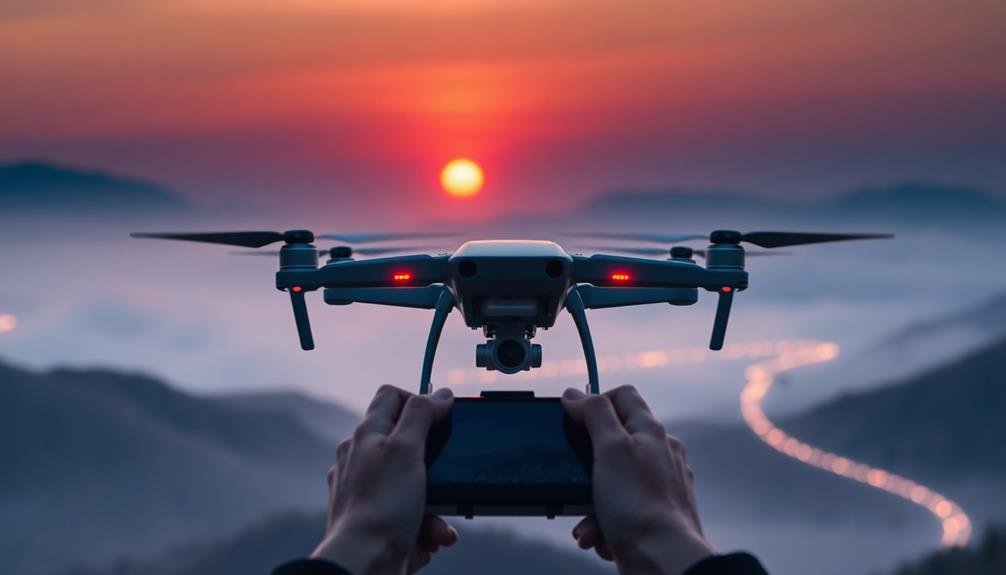



Leave a Reply